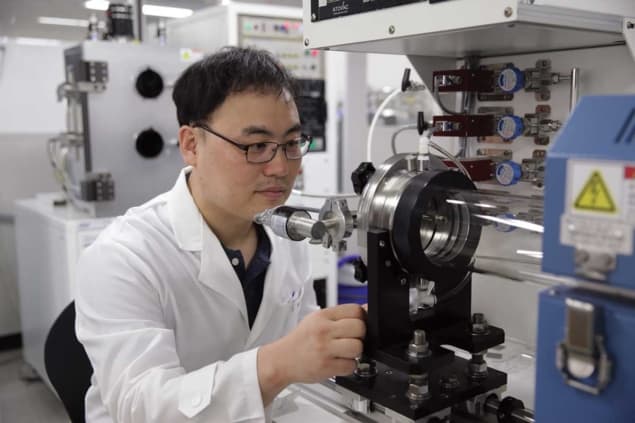After pioneering methods for synthesizing graphene on a large scale, Byung Hee Hong founded a company, Graphene Square, to commercialize the process. Here, he reflects on the different challenges of growing graphene and growing a company

Why did you decide to start your company?
It was very simple. Our laboratory was one of the first in the world to synthesize very large-scale graphene – this was in 2009. We received a lot of requests for samples from other laboratories, and I started to distribute our samples to these groups. Then, at some point, the number of collaborating groups passed 80 and my students were complaining because they were too busy to prepare the samples. So I decided to set up a company to provide samples for other researchers. Then some of these people started asking us about equipment for graphene synthesis, too, and we started an equipment business in 2012. That was when the formal company began.
What had your career been like up to then?
I’m originally a physical chemist, but then I got my PhD in nanoscience and I spent three and a half years in the physics department at Columbia University, US with Philip Kim, a very well-known researcher in the graphene field who is now at Harvard University, US. When I was at Columbia I worked on carbon nanotubes, which are similar to graphene in some ways; in particular, the synthesis method is very similar. I got into graphene research after I moved to Sungkyunkwan University, South Korea in 2007.
Were you looking for opportunities to start a company?
No, never. I was just a university professor before my students started complaining about making so many samples! But because my background is in chemistry, it was maybe a bit easier for me to start a company that provided materials. Today, though, graphene has become much more popular and we are getting more requests from big companies such as Samsung and LG, so our purpose is very different from what it was five years ago. Initially, we didn’t need much funding. Chemical vapour deposition equipment is quite simple, and the company was very profitable right from the beginning: in the first or second year, the sales volume was already half a million dollars. So although I spent some of my own money to set up the company, we didn’t need to receive large amounts of investment at that point. But now we are looking for funds from venture capitalists.
Who did you bring in to help you, and what did they contribute?
There are some good programmes for start-up companies in Korea, both government- and university-supported. I got a lot of advice from them. Also, although I moved to Seoul National University in 2011, I got a lot of support from Sungkyunkwan as well. The most important asset in our company is the intellectual property (IP), and Sungkyunkwan is actually owned by Samsung, so they understand the importance of IP very well. Later, we brought in a very good person, In Hee Lee, a former vice-president of 3M, to act as our strategic adviser. He is trying to help us develop our laboratory technology into a commercial technology.
What has been the biggest challenge for you in growing the business?
Our method of growing large areas of graphene was only invented in 2009–2010, so the technology is not mature. We still need a few more years of development before we can meet the demands from industry. But in addition, as a scientist, I thought, you know, our technology is the best, and probably that will be the most important thing for making a successful business. But actually, it wasn’t. After a few years I realized that business is totally different from technology – even if you have the best technology in the world, without help from people who know about business, investment, finance, marketing and so on, the company cannot be successful.
What are your plans for the future?
So far, the company has been focused on the R&D market. But the research market for graphene is not large and there are other companies similar to ours, so the market is pretty much saturated. So we are moving to the next stage. We recently started a project with LG Display, and if our initial proof-of-concept product is successful, they are willing to use graphene in their mass-produced products. But in that case, the volume of graphene synthesis required will be much larger than we can produce on a laboratory scale. So scaling up to mass production is very important for us now. If we can get investment from venture capital we will be able to set up a manufacturing production line for using graphene in OLED displays.
What do you know now that you wish you knew when you got started?
If I could go back, I would like to know more about the business side of things – not to be an expert in business, but to know how to communicate with business people, and to know a little bit about finance and also about the related laws. As a founder of a company, without that knowledge I made a lot of mistakes. So any scientists who are interested in starting a company should learn the language and the systems used in business, finance, marketing and so on.
Do you tell your students that?
Yes, I always tell my students that they have to be ambitious. Of course, fundamental science is very valuable and important, but bringing technology to real life is also valuable. I respect the Nobel prize and other achievements in fundamental science, but people who have success in industry, in engineering and commercialization also need to be respected. Scientists live in a small world, and technology and commercialization is a totally different one. We probably have many things to learn from industry.



